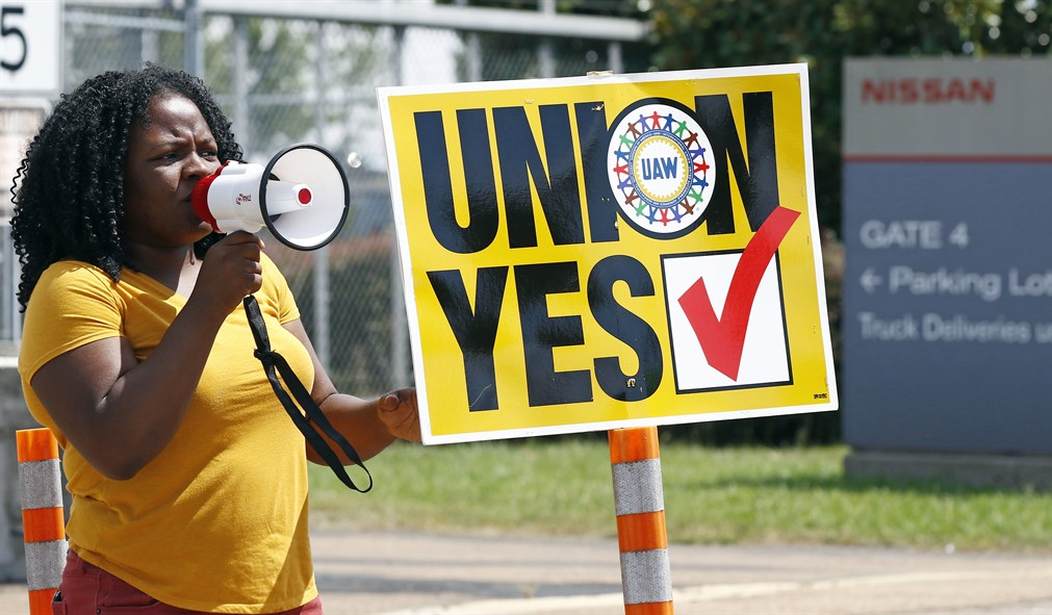For the media and union executives, the United Auto Workers (UAW) strike against automotive plants in Missouri, Ohio, and Michigan is the gift that keeps on giving. A strike of this magnitude becomes a constant churn of news and opinion pieces on two main fronts. Some stories center around the dramatic risks workers take to get their “fair share,” while others focus on the “biggest ever” or “record” demands made by aggressive union executives. Either way makes unions look important and makes union leaders look like power brokers.
But the impact of UAW’s strike is nothing compared to the economic damage government union executives are doing with public sector unions.
The UAW strike started with 13,000 of the Big Three’s 146,000 American auto workers, with later walkouts in other states involving 5,600 more. Even if the strike lasts as long as one month, some economists estimate a 0.2 percent impact on gross domestic product growth (GDP).
Car manufacturers could have lost as much as $1 billion during the first 10 days of the strike, and the overall sector may lose $5 billion. But we’re talking about an industry that contributes as much as $1 trillion to the American economy, anywhere from 3 to 4.8 percent of GDP. New car buyers won’t see an immediate effect, and long-term effects have to do with supply—something automakers attempted to mitigate by growing inventories before the strike.
In contrast, those running the country’s largest public sector unions—supposedly representing teachers, municipal and state workers, and first responders—impose far more significant costs across the country. The Heritage Foundation estimates government unions increase spending by state and local governments by anywhere from $127 billion to $164 billion annually. And, unfortunately, those costs fall directly on taxpayers, strike or no strike.
Take just the four largest government unions—the National Education Association (NEA); American Federation of Teachers (AFT); American Federation of State, County, and Municipal Employees (AFSCME); and Service Employees International Union (SEIU). NEA, AFT, AFSCME, and SEIU bargain with state and local government agencies in 48 states.
Recommended
In Pennsylvania alone, newly negotiated collective bargaining agreements for state employees include a 20 percent pay raise, expected to cost taxpayers an additional $3.2 billion over the life of the contract. The new contracts in Pennsylvania cover 62,231 state employees, less than 1 percent of total government union membership.
Contracts aren’t the only public sector union-related cost taxpayers must bear.
Union-negotiated public pensions are a significant cost driver for state governments. Most states don’t fully fund these pensions. As of June 30, 2023, only Tennessee, Washington, Utah, and South Dakota have fully funded public pensions. Government-union-friendly states, such as California and Illinois, have unfunded pension liabilities exceeding $200 billion. Taxpayers in these states will be left to foot the bill for these excessive liabilities.
Government unions can easily drive up contract and pension costs because of their leverage at the negotiating table. Pennsylvania, California, Illinois, and other union-friendly states permit public employee strikes. Though uncommon, these strikes can have devastating effects that far exceed those of a private sector strike. Citizens rely on their government for necessities like public safety and education. In the event of a public employee strike, these services would grind to a halt.
Consider the recent teacher union strike in Penns Manor School District. The strike interrupted the middle of the school year and put the district at risk of missing the required 180 days of instruction. Though only eight days, the strike disrupted the lives of students and parents, who scrambled to find last-minute childcare.
As such, the mere threat of a public employee strike often gives government unions the leverage to achieve their collective bargaining goals. Limiting the scope of bargaining in the public sector and making strikes illegal could ensure that contracts are negotiated fairly and benefit of taxpayers and workers.
Government unions have steeply increased contract and pension costs, which taxpayers are ultimately left to bear. As state and local governments increase taxes to meet the demands of contracts and pensions, the economic impact of entrenched public sector unionism will far exceed that of a temporary UAW strike.
David Osborne is the Senior Fellow of Labor Policy with the Commonwealth Foundation, Pennsylvania’s free-market think tank.

























Join the conversation as a VIP Member